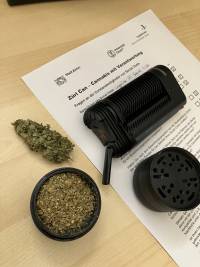- THC & Law:
Vaporizing instead of smoking - the new pleasure
Vaporization technology has outgrown its infancy. Meanwhile, there are very well-functioning devices that can quickly and easily produce a clean THC slice. Without smoke and stench. But with an incredibly clear high.
How does a joint work?
After the first stoner experiences, it is a great event for every THC lover to be able to build a joint by themselves. However, very few people are aware of why this actually works - the main thing is that it works, that it goes in. And even many older smokers are not aware of how it actually comes about that it goes in.
When we light a joint, an ember develops that gets hotter the more we pull the joint. The temperature in this ember ranges from about 500 degrees at rest to about 1000 degrees when we pull. Any THC that was in this ember, however, can never go in, as it is simply burned up. In the best case, it produces CO2 and water vapor. In the worse case, due to incomplete combustion, lots of toxins. These are then drawn through the joint and the filter and end up in the lungs.
Central are not these substances for the running in: The air heated by the embers flows through the joint and heats the THC present there. This causes the THC molecules to change from the solid phase in which they naturally exist in the resin to the gaseous phase and can enter the lungs. There they are absorbed by the blood and a short time later they reach the brain, where they dock with the nerve cells and trigger what we call a “slice” or “high”.
A joint is therefore something very inefficient: A large part of the THC can never enter the body, because it is burned in the embers. But a lot of smoke comes along with the dissolved THC. Nicotine is transported into the body in the same way. Be it in a joint that contains tobacco as well as hemp, be it in a pure tobacco cigarette.
How does a vaporizer work?
The basic principle of vaporization is to try to construct the heat source (in the joint, the embers) in such a way that that hardly any pollutants are produced (FOPH fact sheet). So you just want to heat the THC and the flavors to the point where they become gaseous and can be absorbed into the lungs.
This, of course, presents several problems. THC begins to vaporize at temperatures above about 150 degrees. In chemistry literature, one finds the value 200 degrees for the boiling point of THC. In practice, vaporization begins at lower temperatures. But at temperatures from about 250 degrees plant material (hemp flowers, tobacco) begins to burn (so you have then the same as in a joint or a pipe). And even before that, at about 220 degrees, plant material starts to turn black - it doesn't burn, but it slowly chars.
This brings us to the crux of the problem: How do you design a heat source that generates the heat necessary for THC to vaporize, but doesn't generate the kind of heat that triggers combustion? If the temperature is too low, it just smells fine like hemp, because the essential oils of the hemp plant already enter the gaseous phase at room temperature (otherwise hemp products wouldn't smell). But it doesn't break in, because for the disc the THC evaporation is necessary. (THC is tasteless, by the way.) If the temperature is too high, the material starts to coagulate or burn (and then you could have burned the whole thing in a chillum more cheaply without an evaporator).
The necessary temperature range of about 170 to 230 degrees can be achieved with various tools: Hot air dryer, light bulb, heating block. Which of these things you use, does not really matter. The main thing is that it works! (Continues below.)
Question not answered?
Are the nuances not yet clear to you? We can talk it over in person at the next members' meeting in a relaxed atmosphere.
Do you need legal help?
Have you come into contact with the law? We offer personal legal information.
All clear?
If this page has helped you, please support our work!
Where does the legalization stand in 2024?
On News → Politics you will find an overview of what is currently going on.
Camouflage yourself 👮
Follow our tips for camouflage!
What are the main differences?
When you start experimenting with vaporizers, you have to give yourself time: You have to get to know the machine, learn to use it. Furthermore, the high is also different. Especially if you normally smoke joints with tobacco and hemp, the difference is striking. Because if you vaporize exclusively hemp flowers or hash, you naturally get a pure THC slice. And that is quite different from the mixed nicotine-THC slice from the usual joints. However, you can also vaporize tobacco, and then this difference falls away.
But the break-in is slower than with the joint, but lasts longer. It is more like eating cannabis. However, the THC-vapor works a lot faster than an edible. What is also omitted: the feeling of smoking in the mouth, throat and lungs. The vapor of a vaporizer has a much lower density than smoke. The gout is indeed massively more intense - all the flavors of hashish or weed can be enjoyed. At the same time, however, you have the feeling that you are not inhaling anything. Only after a few minutes do you notice how the THC enters, so that something was in it after all. If you consume cannabis with a vaporizer, you have an absolutely pure THC slice: clear, fun and at high doses simply stunning.
And it doesn't reek of smoke. Only a fine whiff remains after exhaling and dissipates within seconds.
Advantage joint?
A joint has of course its advantages: It is quickly made, the utensils for it (Papierli, filter, hemp flowers, lighter) are easy to transport and cost (with the exception of really fine hemp herb…) not much and are available at any kiosk.
Electric vaporizers, on the other hand, need power, whether from a wall outlet or a USB powerbank. When the battery is empty, some devices need to be charged before they can be used again (others can be used while charging).
Good vaporizers cost (as of 2023) from about 200 francs.
Advantage evaporator?
There is no smoke! This is certainly the most impressive advantage of a good vaporizer. You can consume cannabis anywhere, even in non-smoking areas. Of course, hemp vapors develop, which you can still smell after exhaling. But these dissipate extremely quickly and even hardcore non-smokers do not feel disturbed. Ventilation is unnecessary and you can consume incredible amounts of THC without producing smoke and stench or your lungs going on strike.
The THC is used more efficiently! With the same amount of cannabis herb you can get stoned two to six times (depending on how often you repeat the vaporization process). This saves money and procurement stress, and makes the high prices of a vaporizer pale in comparison - especially in the long run. Especially since you can vaporize light, weak flowers with lots of leaves without sacrificing flavor. You also don't have to pick out the leaves and stems from the weed anymore - the vaporizer and the taste is not disturbed one bit, on the contrary: The last resin drops are made accessible to the smokers…
The lungs are happy! The vaporizer “Volcano” was the first device to be scientifically tested in a study: They wanted to know what kind of substances are in its vapor. The result is stunning: The vapor consists of over 90% of the cannabinoids THC and CBN. The rest consisted of caryophyllene (the scent of cannabis products), as well as a polycyclic aromatic hydrocarbon (this is one of the problematic substances that can be found in smoke several times and in much higher doses). But one should not necessarily conclude from the results of this device to all other “vaporizers”. There are excellent, good, bad and simply not working vaporizers on the market. There are some companies that can not necessarily keep their promises.
More articles on the topic
Support our work with a donation:
Bank transfer
Account number (IBAN):
CH02 0900 0000 8709 1354 3
Full account details
Or scan this QR code with your eBanking App (ZKB, Revolut, Postfinance, …):

Or open/share the QR code as PDF file with your eBanking App.
Credit card
Donate via credit card
Verein Legalize it!
Quellenstrasse 25
8005 Zürich
Threema ID 7NH65RBY
Don’t miss anything! Follow us on social media:


